Patronage & Devotion in Ancient Irish Religion
Published in Features, Issue 4 (Winter 2000), Medieval History (pre-1500), Pre-Norman History, Volume 8
Entrance stone at Newgrange (Brugh na Bí³inne)-bequeathed, according to tradition, by the Daghdha to Aenghus. (Díºchas, The Heritage Service)
Archaeological sites and artefacts represent the only available sources for the pre-Celtic tradition of Ireland, and interpretation of these is a complex and generally risky task. It is generally held that the origins of the Celtic culture in the country lie in or about the fifth century BC, and the nature and import of our tradition would hardly allow us to claim an earlier date than this.
Problems of interpretation
Many researchers have attempted to use the very rich sources of Irish literature in order to determine what was the mythological lore possessed by the Celtic and Celticised people of late prehistoric Ireland. This literature, as is now widely recognised, is not in itself a completely reliable source, principally because it begins in the sixth century AD and therefore post-dates our subject by a thousand years. An additional difficulty is that it was committed to ink by Christian writers, who would have had theological reasons to alter the tradition which they had received and to set it in a new context. When further difficulties—such as dynastic propaganda and fictional dramatisation—are taken into account, the task of reconstructing the religious beliefs of the pagan Irish might appear a hopeless one. These difficulties, however, can be at least partially offset by the proven strength of tradition in Ireland and the notable parallels with data attested from other parts of prehistoric Europe.
We may perhaps begin by symplifying our terminology somewhat, in which case we can talk of Celtic arrivals in Ireland, whether these were actual incomers or an incoming culture. There are, in fact, reasons for considering these ‘arrivals’ in both senses, for it can hardly be denied that there were some sorts of migrations into the country at the beginning of this period, regardless of the actual numbers, and that such migrations continued for some centuries. The population names cited by the geographer Ptolemy in the second century AD have enough parallels with those attested for Britain to demonstrate this, and it is underlined by the fact that Irish is a Celtic language and that there is evidence for the survival of no other language in Ireland into the historical period. It may also be stated, in view of the present tendency among scholars to dismiss the idea of population movement in favour of ‘acculturation’, that all the written historical evidence for the rise and fall of the Celts in ancient Europe involves conquest and a considerable degree of migration.
The Daghdha
Speaking, therefore, of incoming Celts and their incoming worldview, we can visualise how they considered the culture of those earlier inhabitants with whom they were trading, fighting, and cohabiting. The mythological lore reflected in the literature provides plenty of material for such theorising. Several, perhaps indeed most, of the names borne by mythological characters in the literature can be identified with names given to deities among the Celts generally. Most significant is the name of the great father-figure of Irish mythology, the Daghdha. This derives from a Celtic *dago-Dévos (‘the good god’), the word *dévos being cognate with the general name for the sky-deity among the speakers of various Indo-European languages (Latin Deus or Dis, Greek Zeus, Indic Dyâus, Germanic Tyr, etc.). Indeed, one Italic version Jovis Pitr (Jupiter, meaning ‘sky-father’) provides a parallel to the term for this Irish deity Daghdha, who was referred to as Oll-Athair (i.e. ‘all-father’).
Whereas other Indo-European versions of this deity signify the sky, our Daghdha was identified rather with the sun. This slightly different focus may have been aided by a strong sun-cult already in Ireland among the neolithic and bronze age peoples, who in all probably spoke non-Indo-European languages. We can therefore regard this as one example of a merging of pre-Celtic with Celtic beliefs in Ireland. It can hardly be doubted that the winter solstice phenomenon at the Newgrange tumulus is evidence of such an ancient sun-cult, and it comes as no surprise that the Celtic ‘dago-Dévos’ came to be domiciled in that tumulus, which in Irish is known as Brugh na Bóinne (‘the hostel of the Boyne’).
That great enemy of the Celts, Julius Caesar, reports that the Gaulish druids taught that ‘they are all descended from a common father Dis’ and that for this reason ‘their unit of reckoning is the night followed by the day’. The import of this is that the night, as the period of darkness, was seen as particularly appropriate to the ancestor-deity. A similar system of computation survives still in Irish, the word oíche (‘night’) being taken to mean the night before or ‘eve’ of a festival. Indeed, in computing the year the phrase is still used ó Shamhain go Bealtaine is ó Bhealtaine go Samhain (‘from November to May and from May to November’), thus dividing the year into the dark half and the bright half.
This division into the dark or ancestral aspect of life and the bright or current aspect is reflected in many ways in Irish tradition in contests between characters called respectively Donn and Fionn. At the origin of this we can deduce an early Celtic belief based on the movement of the sun, which each night passed underneath the earth through the ‘dark region’ of the ancestors and on each day following returned to preside over the world of the living.
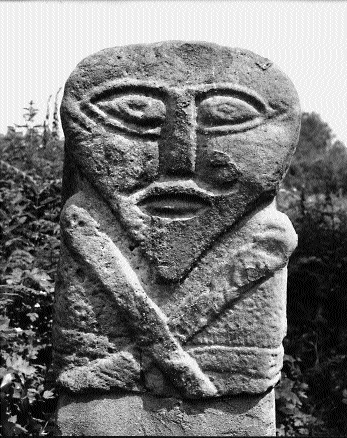
Carvings in stone on Boa Island, County Fermanagh-thought to represent pre-Christian deities. (Díºchas, The Heritage Service)
But, of course, when it was dark in this world it was bright in the otherworld, which seems to have been the rationale of early Irish druids and seers seeking their inspirational light from the dark world of the ancestors.
Dánuv
In other words, the Daghdha, as the great ancestral patron-deity, regulated time and the seasons and was responsible for agricultural and other forms of prosperity. He was represented in early Irish tradition as having a great cauldron of plenty, from which none of his devotees went away empty. His consort, representing fertility, must have been the mother-goddess. We can take it that the basic rationale was that prosperity came into the human world from the union of the sun-father and the earth-mother. The Celtic mother-goddess was known by several names, but her earliest designation seems to have been *Dánuv, which again is attested as a goddess-name among various Indo-European peoples (Indic Dánu, Greek Danaë).
This Indo-European goddess was especially associated with rivers (Danube, Don, Dnieper, etc.), and we know that the British and Continental Celts also had special veneration for river-goddesses—for example the Marne from Celtic Matrona meaning ‘exalted mother’. Especially revealing are the river-names Don and Doon in Britain, as well as Dôn as the mother of the gods in Welsh tradition. This is synonymous with the well-known designation for the divine pantheon in Ireland, Túatha Déa Danann (‘tribes of the goddess Danu’, later written as Tuatha Dé Danann). Various Irish rivers were identified with a goddess—such as Déa (Celtic *Déva, meaning simply ‘goddess’), which was the old name for the Glendalough river, or in less ancient form the rivers called Banda (‘goddess’, e.g. the Bann and the Bandon). Other rivers have alternate goddess-names e.g. Bóinn (Celtic Bouvinda, meaning ‘she who is bovine and brilliant’), Laoi (Celtic *Logia, ‘female calf’), Brighid (‘the highest one’), Sionainn (Celtic Sena, ‘the ancient one’). These may well have been in origin pseudonyms for Danu.
The fertilising quality of water on the soil would mean that the mother-goddess could be taken to represent both rivers and land. Her identity with the landscape is clear from the ancient name Dá Chích nDanann (‘the Two Paps of Danu’) given to two mountain peaks on the Kerry-Cork border. A confusion of this toponymic caused it to be misunderstood as Dá Chích nAnann, hence the development of the idea that Anu (meaning ‘wealth’) was the special land-goddess of Munster. A much older pseudonym for the land-goddess was Celtic *Rigantona (‘exalted queen’), which survived into Welsh as Rhiannon, and into Irish in slightly extended form as Mor-Ríoghain (‘phantom queen’) or Mór-Ríoghain (‘great queen’).
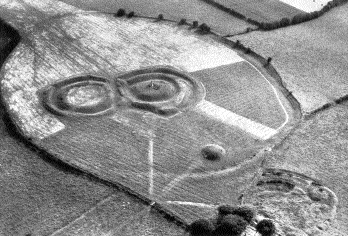
Tara, County Meath (Teamhair na Ríogh)-the leading site in traditions of divine kingship. (University of Cambridge)
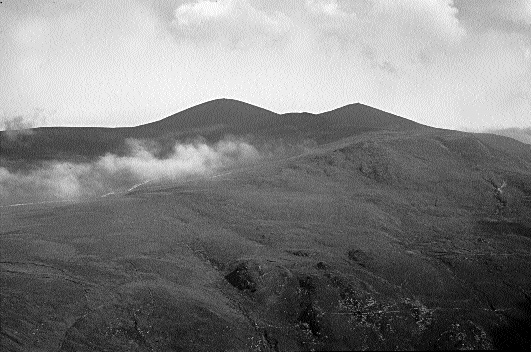
The Paps (Dá Chích nDanann), east of Killlarney, County Kerry-the earth as the body of the goddess. (Díºchas, The Heritage Service)
That this must have been in origin a titular name for Dánuv is suggested by a great deal of evidence, not least by the fact that two hill-tops in County Meath were anciently known as Dá Chích na Mór-Ríoghna, just as the peaks in west Munster were called Dá Chích nDanann. When the literature describes the Daghdha as mating at a river with the Mor-Ríoghain, therefore, we can take it that Danu is really meant.
Much of what we know of early Irish mytho-religious belief can be viewed as a complex of ideas springing from this relationship of sun-father with earth-mother. The living society itself was thought of as the main product, the ‘son’ of the divine couple. We find this expressed very neatly in a medieval story, which must have developed from earlier lore. It concerns a youth called Macán Óg, who had the nickname Aenghus (‘true vigour’), and was the son of the Daghdha by the lady Bóinn. This handsome youth asked his father for a loan of the Newgrange tumulus ‘for a night and a day’, and the Daghdha agreed to this. Aenghus, however, kept the dwelling forever by claiming that ‘it is in nights and days that all time is counted’. The word-trick used by Aenghus must be a medieval elaboration borrowed from folklore, but otherwise the format and imagery has an archaic ring to it. This all the more so because the name Macán (Irish Celtic *Maqanos) is identical with Maponos, the name of a Celtic youth-deity attested from Britain and the Continent.
To underline the antiquity of this format, it should be mentioned that the medieval Welsh development of Maponos is the character Mabon, whose mother is called Modron. This latter is a Welsh development of Celtic Matrona (‘exalted mother’), whom we have encountered as a version of the mother-goddess. In fact, there are distinct parallels in medieval Welsh stories between this Mabon and a character called Pryderi, who is the son of Rhiannon, the cognate of the Irish Mór-Ríoghain and whose father was Pwyll, lord of the otherworld. The conclusion is unavoidable that we are here dealing with the concept of a kind of ‘sacred family’ of Celtic belief, and that the father of Mabon (though unmentioned in Welsh tradition) must originally have been synonymous with the Daghdha.
Rituals of kingship
This idea of the human society being descended from a divine couple was expressed most clearly in the rituals of kingship. Echoes from these rituals which survived in the form of medieval stories place many sun-taboos on kings. For instance, the king of Tara, it was said, should not enter that fortress after sunlight and should not leave it before sunrise. The import is that the sun in some way presides over the reign of a king. This can further be connected with the well-known idea in Irish literary tradition that the reigning king is the protector or ‘husband’ of the land. All of this can best be understood by surmising that the sun-father hands over the kingship to the living king for the duration of his reign, and that the king is in that way the temporary occupant of the deity’s earthly realm.
This is not to suggest that an ‘Oedipus-complex’ was inherent to early Irish mythology. It is apparent that the notion of the reigning king being carer or ‘husband’ of the land-goddess was in origin extraneous to the tradition of the ‘sacred family’, and that it rather arose from rhetorical material associated with the inauguration of individual kings. This could be accommodated to the earlier idea of the king, as representative of his tribe, being the ‘son’ of the god and goddess, by regarding the spirit of the earth as renewable in different personae. As the crops grew anew each year, so a new goddess could be born, which would allow her to be a descendant of the mother-goddess just as the king was a descendant of the father-deity.
In all of this, the tendency in medieval Irish narrative to humanise and dramatise ancient deities presents us with something in the nature of a jigsaw puzzle. Not only is much of the earlier tradition couched in the form of love stories, but also there are definite plot-structures which recur. Instances of such plot-structures are the ‘Mélusine’ plot which tells of an otherworld lady becoming the wife of a mortal man, and the ‘three-cornered’ plot which has an old man and a young man contending for the hand of a maiden. We have already met with a medieval development of contention between the Daghdha and Aenghus because of the adoption of a trick-story into their context. Such plots must have intruded into the mythology from migratory folklore, because some of their imagery was thought to coincide with the mythic material. The net result of their borrowing, however, was to put that mythic material somewhat out of focus.
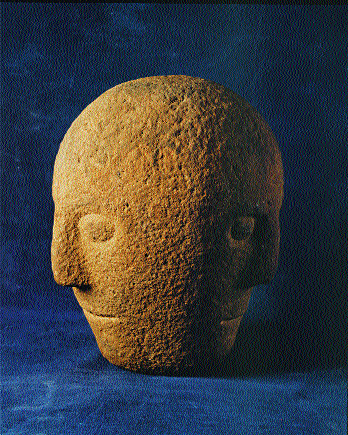
The Corleck Head-probably a symbol of the unity of past, present and future. (National Museum of Ireland)
As the original mythic format became fudged by these and other extraneous plots, the theme of incest was suggested. It is interesting to note, however, that incest as a motif in the medieval Irish stories concerns the father-daughter format rather than the mother-son one. In one story, for instance, a king called Eochaidh marries a maiden Éadaoin who, unknown to him, is the daughter of himself and his wife Éadaoin. This is significant, for the Eochaidh is elsewhere cited as an alternative name of the Daghdha, and the name Éadaoin (‘she who evokes jealousy’) is a pseudonym for the goddess of sovereignty. We may consider this as contaminated evidence for what has been said above concerning the renewability of land-goddess personae.
Returning to the idea of the reigning king as ritual ‘son’ of the divine couple, it has not previously been noticed by researchers that there is in fact a parallel in the Irish sagas to the nomenclature involved in the story of how the Daghdha yielded possession of the tumulus to Aenghus, the Macán Óg. This concerns the well-known situation in the Ulster Cycle, whereby king Conchobhar is given the kingdom by the older occupant Fearghus, who remains in the role of a kind of seneschal or royal advisor. The full name of this latter character is Fearghus mac Ró-Eich (literally ‘male vigour son of great horse’). The ‘great horse’ is well-attested as a symbol of the Daghdha, whose cognomen was Eochaidh (‘horseman’) or Eochaidh Grian-Éigeas (‘Horseman Sun–Seer’). In fact, Fearghus is in one story said to have had a great horse, each mór. This latter recalls how the Gaulish version of the sun-deity Apollo was described as epomaros (literally ‘horse-great’).
Briefly stated, the designation of the Macán Óg as Aenghus mac an Daghdha (‘true vigour son of the good sky-god’) parallels in imagery the name Fearghus mac Ró-Eich (‘male vigour son of great horse’). The seneschal character in the Ulster Cycle must have been originally known simply as Ró-Each, and his name was extended due to confusion with the full phrase which expressed the role of the incumbent king vis-à-vis him.
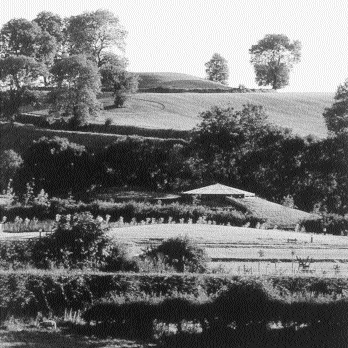
Eamhain Mhacha, County Armagh-cultic centre of the ancient Ulster folk.
The phrase itself, as we may suspect, was detritus from rhetorics used in the inauguration of kings. This interpretation is strengthened by the literal meaning of the name given to the incumbent king in the cycle, Conchobhar (‘beloved of warriors’), which reflects the image of the typical Iron Age Celtic king surrounded by his warrior-band.
The upshot of all this is that the rituals associated with the inauguration of early Irish kings was derived from the Celtic ‘sacred family’ symbolism which we have mentioned. Indeed, in the medieval literature of the Ulster Cycle itself, the patroness of kingship, Macha, races against horses. This is significant, for the name Macha can be shown to be a mere substitution for her earlier designation, which was Mór-Ríoghain. This explains the curious parallels between the Macha of the Ulster Cycle and Rhiannon of Welsh tradition, and indeed their similarities with the Continental Celtic iconography of the horse-goddess Epona. The insular Celts had clearly preserved the respect for horses which resulted from the importance of these animals to the Hallstatt and la Tène chiefs.
Further influence of the ‘sacred family’ format can be deduced from the tradition of the seer Find (later known in story as Fionn mac Cumhaill), who seems to have been in origin a personification of druid-lore. This Find was intimately associated with the river Bóinn, and we can decipher an earlier outline which had him gain his wisdom from a patron-character called Ruadh Ró-Fheasa (‘red one of great knowledge’), which was a descriptive appellative for the Daghdha. The same pattern, therefore, holds true here also, except that in this case it has been adopted by the druids in order to bolster their social image. Evidence could be produced that other gods of skills and of trades, such as Lugh, Goibhniu, Nuadhu, and Dian Cécht, were assimilated to the ancestral deity, though in a more social and less immediate sense.
Veneration for tribal tradition
It is difficult, if not impossible, to recover the personal religious attitudes of ordinary people in pre-Christian Ireland—what solace the individual, whether prosperous or poor, could gain from a perceived relationship with a spiritual world, and what practices were carried out in the context. It can be said in general, however, that cures for sickness and guidance in skills figured prominently, that there was belief in the rationale of magic, and that there was some notion of the continuance of life after death. Space does not permit here a fuller discussion of these and related aspects. What is clear from what we have been saying, however, is that in official culture the fundamental religious belief was concerned with the descent of the tribe from the father-deity, and as a consequence with the veneration of ancestors. Veneration for tribal tradition was proclaimed as the greatest guarantee for human welfare.
The deities themselves were thought of as tribal in culture. Among the Gauls, the term Teutates (‘the tribal ones’) was used for deities, and in Irish tradition—as we have seen—the gods were referred to as Tuatha Déa Danann (‘tribes of the goddess Danu’). It is therefore not surprising to find, in the heroic sagas, the most binding oath takes the form tongu día tonges mo thúath (‘I swear by the god by whom my tribe swears’). Various tribes had their own name for their god—a list would include such as Dáire, Lughaidh, Find, Cathaír, Cond, Ailill. Some of these derived from pseudonyms for the Daghdha and from his emanations, some from specific deities of trades or places, others perhaps from legendary accounts of great ancestors. That the image of the ultimate father-deity stood behind them all, however, is strongly suggested by the admonition by St Patrick in his Confessio not to adore the sun in the sky, but to adore Christ instead, ‘the true sun’. Indeed, an early legend concerning Patrick has him overcome and convert a great apocryphal pagan called Dáire who, like the Daghdha, has a great cauldron and is lavish with his gifts.
Dáithí Ó hÓgáin is Associate Professor of Folklore at University College Dublin.
Further reading:
D. Ó hÓgáin, The Sacred Isle (Cork 1999).
















